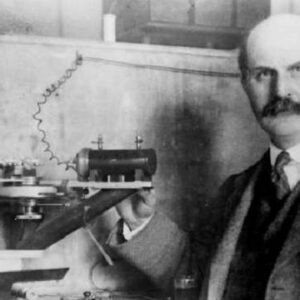Sir William Henry Bragg was a British physicist whose son, William Lawrence Bragg, received the 1915 Nobel Prize in Physics with him. The father and son received the Nobel Prize “for their contributions to the X-ray study of crystal structure.” William Henry Bragg was a man of many talents; he was a physicist, chemist, mathematician, and athlete. Early in life, he lost his mother and was raised by his uncle. He went on to get a scholarship to Trinity College, Cambridge, due to his academic prowess. After graduating from Cambridge, he worked at the University of Adelaide as a professor of mathematics and physics. After 23 years in Australia, he returned to England and enrolled at Leeds University. During this time, he and his son conducted research on the analysis of crystal structure using X-rays, for which they were awarded the Nobel Prize. During the First World War, he also assisted the British government in the identification of submarines. Throughout his life, he received numerous awards and accolades, and he will undoubtedly be regarded as one of the finest scientists of the 20th century.
Youth and Early Life
William Henry Bragg was born in Wigton, England, on 2 July 1862 to Robert John Bragg and Mary Wood. His father worked as both a farmer and a merchant navy commander.
His mother died while he was only seven years old, and his uncle, also named William Bragg, was responsible for his upbringing. To live with his uncle in Market Harborough, Leicestershire, he relocated. He attended the Old Grammar School in Market Harborough and then King William’s College on the Isle of Man for his education.
After graduating from high school, he was awarded a scholarship to Trinity College, Cambridge University, where he began his studies in 1881. He studied mathematics under the tutelage of Dr. E. J. Routh graduated in 1884 as a third wrangler. In 1885, he was granted first-class honors in the mathematical tripos.
William Bragg’s Career
In 1885, following his graduation from the University of Cambridge, he was named Elder Professor of Mathematics and Experimental Physics at the University of Adelaide in Australia. The role was assumed the next year.
His interest in physics grew over time, especially in the realm of electromagnetic. He was highly intrigued by Wilhelm Rontgen’s recent discovery of X-rays. His connection with Ernest Rutherford contributed to his increased interest in the field.
William Henry Bragg proved in 1896 to a group of physicians that X-rays might be used to expose structures that were otherwise unseen.
In 1904, he gave a lecture in Dunedin, New Zealand for the Australian Association for the Advancement of Science on the idea of ionization of gases, and his study on the topic yielded a fellowship from the Royal Society of London. In the same year, he also published articles on Alpha Rays and Radium Ionization Curves.
He was also involved in sports throughout his time in Australia. He enjoyed chess, lacrosse, lawn tennis, and golf. He was instrumental in founding both the Adelaide University Lacrosse Club and the North Adelaide Lacrosse Club.
After spending 23 years in Australia, he returned to England in 1908. He was appointed Cavendish Professor of Physics at the University of Leeds the following year.
Bragg invented the X-ray spectrometer during his stay at the University of Leeds. Subsequently, he teamed with his son, William Lawrence Bragg, a research scholar at Cambridge University at the time, to establish a new field of study known as X-ray crystallography. In 1914, he joined the British war effort during the First World War by assisting with submarine detection, and four years later he was appointed an admiralty advisor.
University College London nominated him as the Quain Professor in 1915, but he did not accept the position until he had completed his military service. When he first began working, he focused mostly on crystal analysis.
In 1923, the Royal Institution appointed him a Fullerian professor of chemistry, and in the same year, he was appointed director of the Davy Faraday Research Laboratory.
William’s Major Opera
Together with his son, William Lawrence Bragg, he devised the X-ray spectrometer, and the pair’s research led to the X-ray examination of crystal structure.
Awards & Achievements
In 1907, he was elected a Fellow of the Royal Society, and 28 years later he was named its president. He held the office of president for five years. In 1915, he and his son William Lawrence Bragg earned the Nobel Prize in Physics for their work in crystal analysis. He won the Barnard Medal and the Matteucci Medal in the same year.
He was awarded the Rumford Medal in 1916.
In 1917, he was appointed Commander of the Order of the British Empire, and three years later, he was knighted.
In 1930, he was given the Copley Medal.
Personal History and Legacy
William Henry Bragg married Gwendoline Todd in 1889. The couple produced a daughter named Gwendolen and two sons named William Lawrence and Robert.
He passed away in London, England, on March 10, 1942, at the age of 79. The cause of his passing is unknown.
Estimated Net Worth
Unknown.


